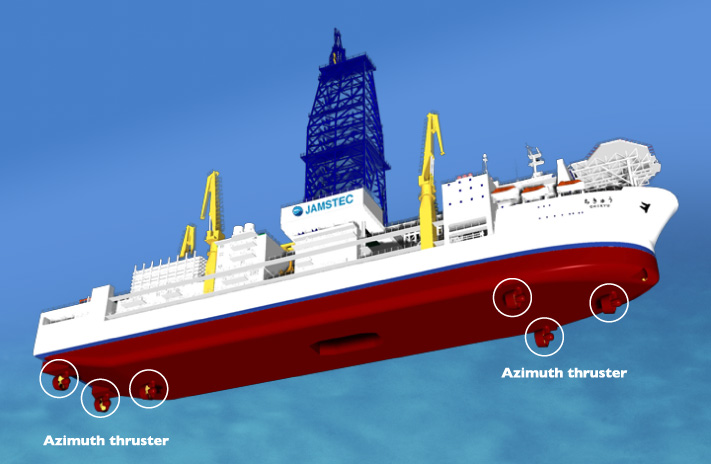
Drilling vessels, including the CHIKYU, must remain in one fixed position in order to drill into the seafloor. However, at sea there are always forces that alter the position of the ship, such as ocean currents and the wind. The propellers that resist these forces and keep the ship in one place are the azimuth thrusters. The CHIKYU has six of these azimuth thrusters. One of these was damaged in the March 2011 earthquake, but after repairs the set of six azimuth thrusters was once again complete after one year and three months.
(Published online September 2012)
| Interviewee: Junya Ishiwata Engineer, Engineering Group,Drilling Operation Group,Center for Deep Exploration (CDEX),Japan Agency for Marine-Earth Science and Technology (JAMSTEC) |
Propellers that can make 360° direction changes
We are not used to hearing the words azimuth thrusters – what are they? A thruster is something that thrusts, or in other words provides propelling force. In the case of ships, that means propellers. Azimuth means direction and indicates the direction of the propeller. Azimuth thrusters are thrusters that can change the direction of the propeller, making a 360-degree turn. The azimuth thrusters of the CHIKYU have a propeller diameter of 3.8m and a rated output of 4,200kw. The CHIKYU is also loaded with diesel engines, but their role is to run the generators. The propellers are rotated by electric motors which are run on electricity generated by the generators.
Drilling ships that move freely at sea also must also remain in one place when drilling takes place. The direction of currents and the wind that carry the ship along change by the minute. In order to remain in one place, the direction of the propellers must be changed at will depending on the direction of the forces the ship is subject to.
“The azimuth thrusters on the CHIKYU consist of propellers and their supporting gear cases, as well as the boxing on top, which are called azimuth thruster containers,” explains Junya Ishiwata. “A motor is located lengthwise inside the container. The motor’s axle goes straight into the gearbox beneath, and generates thrust by changing power through two gears into a horizontal direction and transmitting it to the propellers. “ So, why must azimuth thrusters be constructed like this?
On most ships, the engines are placed sideways, with the axles stretching backwards and piercing the ship’s bottom, and a propeller attached to its tip. With this kind of construction it is not possible to change to direction of the propeller. And therefore it is naturally also not possible to position the ship correctly. “With azimuth thrusters however the axle is placed lengthwise, and with the axle down the center the direction of the propellers can be changed at each gearbox,” explains Ishiwata.
Not only the direction but also the force of the thrust needs to be changed with azimuth thrusters. The forces of the currents and the winds change constantly. The CHIKYU’s thrusters must respond to these changing forces promptly and fully. Ishiwata explains that the CHIKYU’s azimuth thrusters have electric motors with a RPM between 0 and 720. The RPM and torque are adjusted through VVVF (variable-voltage, variable-frequency) inverter control, and the propeller’s rotations are also controlled by fixed reduction gear. The CHIKYU can thus accurately remain in one place, by adjusting the thrust force and direction and by combining it with the DPS (Dynamic positioning System).
Drilling ships that move freely at sea also must also remain in one place when drilling takes place. The direction of currents and the wind that carry the ship along change by the minute. In order to remain in one place, the direction of the propellers must be changed at will depending on the direction of the forces the ship is subject to.
“The azimuth thrusters on the CHIKYU consist of propellers and their supporting gear cases, as well as the boxing on top, which are called azimuth thruster containers,” explains vice head Junya Ishiwata. “A motor is located lengthwise inside the container. The motor’s axle goes straight into the gearbox beneath, and generates thrust by changing power through two gears into a horizontal direction and transmitting it to the propellers. “ So, why must azimuth thrusters be constructed like this?
On most ships, the engines are placed sideways, with the axles stretching backwards and piercing the ship’s bottom, and a propeller attached to its tip. With this kind of construction it is not possible to change to direction of the propeller. And therefore it is naturally also not possible to position the ship correctly. “With azimuth thrusters however the axle is placed lengthwise, and with the axle down the center the direction of the propellers can be changed at each gearbox,” explains Ishiwata.
Not only the direction but also the force of the thrust needs to be changed with azimuth thrusters. The forces of the currents and the winds change constantly. The CHIKYU’s thrusters must respond to these changing forces promptly and fully. Ishiwata explains that the CHIKYU’s azimuth thrusters have motors with a RPM of 720. The RPM and torque are adjusted through VVVF (variable-voltage, variable-frequency) inverter control, and the propeller’s rotations can be freely changed from 0-162 RPM using the reduction gear. The CHIKYU can thus accurately remain in one place, by adjusting the thrust force and direction and by combining it with the DPS (Dynamic positioning System).

- |1|
- 2|


